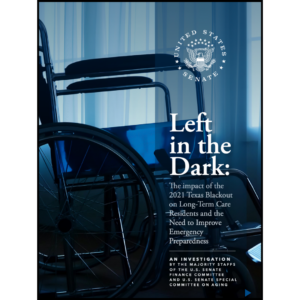Operating a sanitary and safe kitchen
Salmonella…E. coli…C. botulinum… These ominous words have been making headlines. Contaminated or tainted food can have devastating—even fatal—consequences for healthy individuals. Imagine the risk when a frail, elderly, or medically compromised person comes in contact with any of these bacteria. In long-term care environments, the facility kitchen is ground zero in preventing the spread of foodborne illnesses, which is why surveyors pay close attention to kitchen sanitation. Proper food storage and handling, proper maintenance of kitchen equipment, and the health and cleanliness protocols of kitchen staff are all areas to consider. The added bonus is that a clean kitchen is, ultimately, a safe kitchen. This article takes a look at what can be done to ensure that every precaution is being taken to keep your residents safe.
Begin With the Basics
Proper and frequent handwashing may be the simplest—and most immediate—way to operate a sanitary and safe kitchen; however, enforcing rules and making sure all staff members follow the policies and procedures of handwashing can be challenging. Every facility is required to have written policies and procedures in place related to handwashing, hygiene, and the health of foodservice workers. You cannot stress the importance of handwashing enough to your staff; they must be educated on proper handwashing techniques according to the Centers for Disease Control and Prevention (CDC) guidelines (available at https://www.cdc.gov/mmwr/PDF/rr/rr5116.pdf). One way to ensure proper handwashing is to have employees demonstrate their handwashing technique every month. Use a checklist to ensure that every step is followed. Instruct kitchen staff to use a paper towel to turn off the faucet to avoid contaminating their freshly washed hands.
Besides correct handwashing, the overall health and hygiene of your employees is critical. To maintain a safe and healthy kitchen environment, monitor staff for any signs or symptoms of illness (e.g., vomiting, sneezing, or diarrhea) that may cause food contamination and educate staff on the importance of reporting symptoms to supervisors.
Organize the Kitchen
Efficient organization is an important key in kitchen sanitation and safety. Tour and assess the kitchen and pantry areas with this question in mind: Is the kitchen organized, sanitary, and free of physical hazards? Follow the steps below when touring the kitchen to ensure it does not present health and safety hazards.
Assess the environment for hazardous materials.There will always be hazardous materials in the kitchen (e.g., disinfectants, surface decontaminate cleansers, germicides, antimicrobials, bleach, hand sanitizers, and even dish soap). You need to know what could happen if these materials are handled incorrectly or by the wrong person. Once you have identified the potentially hazardous materials in your kitchen, you can develop effective policies and procedures to avoid possible negative outcomes. Store any hazardous materials in a separate, locked cabinet, away from foods. Read labels and product informa-tion on all products, especially non-foods and cleaning agents.
Make sure the poison control telephone number—(800) 222-1222—is clearly posted, and confirm that your material safety data sheets (MSDS) information is easily accessible. All of this information should be covered and logged during employee orientation, as well as during any employee in-services or training.
Look for obstacles or conditions in the area that could contribute to or increase the risk of a fall.Examples include clutter, electrical cords, and slick or cracked flooring. Encourage kitchen workers to wear slip-resistant shoes. A quality brand of slip-resistant footwear will help prevent your kitchen employees from slipping in greasy residue that may remain even after a thorough cleaning of the spill.
F371: Store, prepare, distribute, and serve food under sanitary conditions
Observe cooking, cooling, and storage of food. The 2005 Food Code from the Food and Drug Administration (FDA; available at https://www.cfsan.fda.gov/~dms/fc05-toc.html) offers recommended food cooking, cool-ing, and storing times and temperatures, and sanitary guidelines.
Subject potentially hazardous foods (e.g., milk, eggs, and poultry) to continuous time/temperature controls in order to prevent the rapid and progressive growth of infectious or toxigenic microorganisms.
Sanitize food preparation dishes, utensils, and equipment according to recommend-ed FDA guidelines.
Monitor food storage in the kitchen and in food storage areas to prevent contamination.
F372: Dispose of garbage and refuse properly
Keep areas used for both clean food transport and garbage disposal (e.g., hallways, elevators, and loading docks) free of debris, foul odors, and waste fat.
Cover waste receptacles when transport-ing them from the kitchen to the dumpster.
Make sure waste containers are in good condition with no leaks and garbage is placed in dumpsters or compactors with lids or otherwise covered.
Organization plays a key role in fire safety.Inspect the kitchen for potential fire hazards and make any needed repairs immediately. Fire hazards can include old, worn, or frayed electrical cords; overloaded electrical outlets; and natural gas leaks. Make sure the fire extinguisher is charged, tested, and operational at all times and positioned in a central, easily accessible location. Fire drills, including the evacuation procedure, should be performed on a routine basis, on every shift, and include all employees.
The best training I received was from our local fire department. Every employee was taught how to properly use a fire extinguisher. The fire department then set an actual fire so every employee could practice using an extinguisher. This training proved invaluable when, during an actual fire crisis, I was able to rescue a resident trapped in a burning bed, extinguish the fire immediately, and prevent the fire from spreading. Education and training are vital, but actually practicing what you learned can be even more valuable.
Food Safety
Once your kitchen is organized and free of physical hazards, keeping your food safe and following the guidelines established in Federal tags 370, 371, and 372 will be that much easier (see sidebar). Food containers should be stored on clean surfaces off the floor. Be sure that hazardous foods, such as animal products (including milk, eggs, and poultry), are kept at 41°F or below. Be sure to store raw meats away from fruits and vegetables and check the refrigerator’s temperature with a sanitized thermometer.
Hot foods should leave the kitchen or the steam table at 140°F. When food is transported to resident rooms, it should be protected from contamination with a cover and the cart should be cleaned regularly. Dirty dishes should be washed in the dishwasher at 140°F and rinsed at 180°F (or according to manufacturer’s specifications). If dishes are hand washed, a three-compartment sink should be used (wash, rinse, and sanitize according to manufacturer’s instructions). Finally, although the FDA Food Code is a model and not regulation, it is a valuable resource on food safety (https://www.cfsan.fda.gov/~dms/foodcode.html).
Experienced Manager or Supervisor
An experienced manager or supervisor will know and implement all federal, state, and city rules, regulations, and codes, as well as provide proper food safety education and training to kitchen employees. Date-marking foods, identifying food allergens, using proper food storage methods, overseeing food preparation and distribution, disposing of food properly and following the guidelines of F-tags 370, 371, and 372 are all tasks carried out by a competent dietary manager/supervisor.
Phyllis M. Bouley, LPN, AS, is Clinical Project Consultant at Briggs Corporation. LPN, AS, discusses how a clean, organized kitchen promotes health and safety for residents and staff
For more information, phone (800) 247-2343 or visit https://www.briggs.com. To send your comments to the author and editors, e-mail bouley0407@nursinghomesmagazine.com.
Sidebar
F-Tags Pertaining to Sanitary Conditions
F370: Procure food from sources approved by or considered satisfactory by federal, state, or local authorities
Related Articles
Topics: Articles , Operations , Regulatory Compliance , Risk Management











